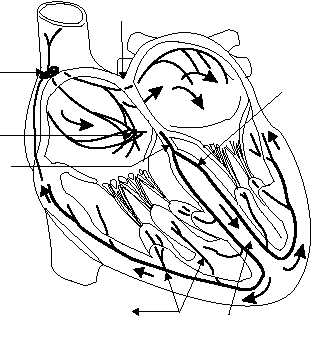Cardiac Cycle
The cardiac cycle is coordinated by specialized
tissues that initiate and distribute electrical (cardiac)
impulses (fig. 1-34). The contractions of the heart are
stimulated and maintained by the sinoatrial (SA)
node, commonly called the pacemaker of the heart.
The SA node is an elongated mass of specialized
muscle tissue located in the upper part of the right
atrium. The SA node sets off cardiac impulses, causing
both atria to contract simultaneously. The normal heart
rate, or number of contractions, is about 70 to 80 beats
per minute.
This same cardiac impulse continues to travel to
another group of specialized tissue called the
atrioventricular (AV) node. The AV node is located
in the floor of the right atrium near the septum that
separates the atria. The cardiac impulse to the AV node
is slowed down by junctional fibers. The junctional
fibers conduct the cardiac impulse to the AV node;
however, these fibers are very small in diameter,
causing the impulse to be delayed. This slow arrival of
the impulse to the AV node allows time for the atria to
empty and the ventricles to fill with blood.
Once the cardiac impulse reaches the far side of the
AV node, it quickly passes through a group of large
fibers which make up the AV bundle (also called the
bundle of His). The AV bundle starts at the upper part
of the interventricular septum and divides into right
and left branches. About halfway down the
interventricular septum, the right and left branches
terminate into Purkinje fibers. The Purkinje fibers
spread from the interventricular septum into the
papillary muscles, which project inward from the
ventricular walls. As the cardiac impulse passes
through the Purkinje fibers, these fibers in turn
stimulate the cardiac muscle of the ventricles. This
stimulation of the cardiac muscles causes the walls of
the ventricles to contract with a twisting motion. This
action squeezes the blood out of the ventricular
chambers and forces it into the arteries. This is the
conclusion of one cardiac cycle.
Blood Pressure
Blood pressure is the pressure the blood exerts on
the walls of the arteries. The highest pressure is called
systolic pressure, because it is caused when the heart is
in systole, or contraction. A certain amount of blood
pressure is maintained in the arteries even when the
heart is relaxed. This pressure is the diastolic pressure,
because it is present during diastole, or relaxation of
the heart. The difference between systolic and diastolic
pressure is known as pulse pressure.
Normal blood pressure can vary considerably with
an individual's age, weight, and general condition. For
young adults, the systolic pressure is normally
between 120 and 150 mm of mercury, and the diastolic
pressure is normally between 70 and 90 mm of
mercury. On average, women have lower blood
pressure than men.
1-27
HM3F0134
INTERATRIAL
SEPTUM
S-A NODE
AV NODE
AV BUNDLE
LEFT
BUNDLE
BRANCH
PURKINJE
FIBERS
INTERVENTRICULAR
SEPTUM
Figure 1-34.—Cardiac cycle.

